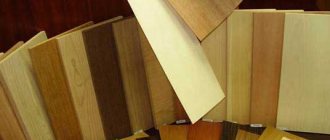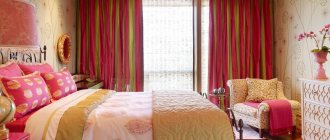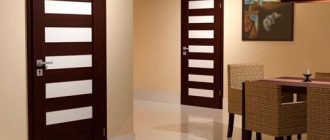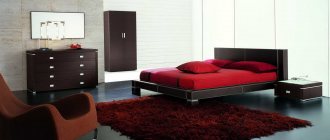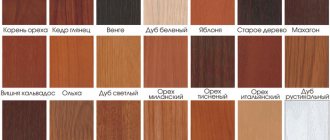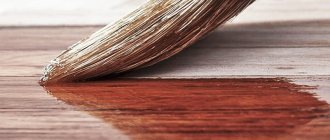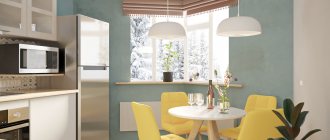Furniture colors
The decision on choosing the color of furniture depends on many parameters: the size and purpose of the room, its design and color palette. To make an effective choice, it is useful to get an idea of the range of materials presented in furniture stores.
In a gray interior Source tobiaszmeble.lh.pl
When assessing the options, you should also understand that cabinet and upholstered furniture made from natural solids are less varied than products made from natural or painted veneer. Color solutions for veneered MDF include dozens of shades, some of which are quite unusual.
Catalog fragment Source xcm-models.com
Features of wood material
Wood is one of the most ancient building materials, the features of which include:
- ease;
- strength;
- density
- versatility of use;
- environmental cleanliness;
- high porosity;
- low thermal conductivity;
- decorativeness;
- good internal air exchange;
- high chemical resistance;
- ability to resist dynamic and static loads well.
Design project: Dmitry and Daria Grigoriev, Alina Ursova
Wooden materials are easy to glue, lend themselves well to machining and firmly hold various metal fasteners.
Light furniture
Thanks to furniture in pastel shades, even a modest-sized room is filled with light and seems more spacious. Light colors furnish classic and minimalist interiors and are a common choice for the bedroom or kitchen. Light furniture is made from the following types of wood:
- Shimo ash. There are several types of material: milk, cream, coffee. A characteristic feature is distinct tree stripes.
Bedroom in a modern style Source bedroom.adstores.ru
- Karelian birch. It has a patterned texture with a beautiful pattern reminiscent of marble. The background is white, light yellow or brownish sand. The pattern is darker - brown to black or with a reddish tint. A unique feature of Karelian birch is its moire pattern, when dark fibers are visible through light ones. The color of their birch furniture is characterized by a glowing effect, giving it a luxurious look.
From solid Karelian birch Source euromebelshop.ru
- Light beech. The structure of the wood is uniform, so the color is distributed evenly. The shades are quite varied: whitish-gray or beige with a pinkish, yellowish or brownish-reddish tint.
- Pine. Material with a pronounced amber texture and brownish-brown stains. Sometimes products are deliberately given a more saturated, almost orange hue.
In addition to the main varieties, light varieties include acacia with a yellowish-gray surface, gray-pearl or matte beige milky oak, alder, apple, and pear.
Pine set
See also: Catalog of companies that specialize in the construction of turnkey country houses
Intermediate colors
When figuring out what furniture colors there are and how they fit with a particular finish, many people pay attention to furniture in intermediate shades. It is valued for its ability to fit into interiors of different color palettes. Often it serves as a compromise for small spaces, when it is important that objects do not look bulky, and white interiors are not liked. Almost all intermediate shades are warm; items are made from the following types of wood:
- Oak. The name rustic oak is often found; means a medium brown shade, close to the color of chocolate or hazelnut shells.
Retro-style bedroom Source russdveri.ru
- Cherry. Includes a whole range of shades from golden to reddish-red and dark red. It is valued by designers for its structure reminiscent of noble mahogany.
- Alder. The wood can have a rich honey, beige-red or reddish tint.
In the green dining room Source i.pinimg.com
Dark colors
Furniture in a dark, rich palette gives the interior a touch of respectability. It is used to create a wide variety of interiors: classic, rustic, chalet and modern. Dark furnishings eat up space, but individual dark objects can be included in the interior of small rooms. Dark tones include:
- Nut. Popular dark brown color, with chocolate, reddish or gray tint. The texture is heterogeneous: beautiful winding stripes, dark veins.
On a light floor Source st.hzcdn.com
- Red tree. Among the various names for furniture colors, this is most often associated with luxury. Several species fall under the name, including sandalwood, mahogany (tropical species), berry yew, padauk. The wood is red-brown or dark cherry in color; The texture and degree of saturation differs among different varieties. Natural wood darkens over time.
How to make your interior truly stylish Source 1.bp.blogspot.com
- Wenge. The color of mature wood is unusually decorative and varied; the palette includes blue-black, chocolate, burgundy tones with black or golden veins.
- Ebony. Depending on the breed, the color can be deep black, dark brown, with a reddish tint, with grayish or beige stripes.
In wenge color Source 4.bp.blogspot.com
See also: Catalog of companies that specialize in interior redevelopment
Exceptions to the rules
Sometimes, when searching for a specific solution, “alliances” are born that do not fit into the framework of the standard design concept. As experts say, “the rules must be broken consciously.”
If the finished interior is unusual, but aesthetically attractive, it has a right to life. For example, an ebony-colored floor looks incredibly impressive together with light-colored furniture, although this is the opposite of the basic rule. When searching, interesting ideas and new combinations often arise that you can safely adopt.
How to combine wood in the interior
In any interior you can find many wooden components. This is not only a cabinet or table, but also flooring (laminate or parquet), a door, a mirror frame. To create a harmonious interior, you should focus not only on the colors of the furniture and their names, but also on the color of the surroundings; The following tips will help:
- When choosing the color of furniture, it is important to consider what kind of interior it is intended for. There are interiors (usually modern) where the accent is important, and its role can be played not only by the closet or doors, but also by the floor covering. In classic interiors, coherence and color harmony are more important.
In the office Source static.wixstatic.com
- Accent. In most interiors, the emphasis is on furniture, with the floor and walls serving as the background. Therefore, it is important that there is a contrast in color between the set and the decoration. In this case, doors and baseboards should match, but doors and floors should not.
- Limitation. It is recommended to limit yourself to two shades of wood in one room to avoid chaos. Three colors are allowed if one of them is white.
On a white background Source st.hzcdn.com
- Combination. There will always be a good result if you combine only warm or only cold tones of wood.
- The shades should not be related, differing by a tone or two - you will always get the impression that you tried to choose a color, and it didn’t work out.
- Unity of texture (pattern). If the surface of the floor or doors has a noticeable ring pattern, furniture, regardless of color, is also chosen with a bright texture. Textiles are chosen using the same principle - colors may differ, but the print must be repeated.
Unity of texture Source veloxng.com
- Unity of finishing style. Harmony will be preserved if all wooden surfaces, regardless of color and species, are processed in the same way: deliberately rough or, conversely, carefully polished.
- Separation. There are two equally disastrous situations: when, for example, the table merges with the floor covering, or when they do not combine in any way. In both cases, a carpet can save the situation. It will separate the table from the floor, creating a distracting color accent.
In the hallway Source dekormyhome.ru
Not happy with the carpet?
But if the carpet under the table or the long path along the set does not suit , then we use the method of “distracting attention” from the wood with bright accents. For example, we place a noticeable holiday decor in the center of the table. It could be:
- glass bright vase
- large bouquet of colorful flowers
- luxurious service in contrasting colors
